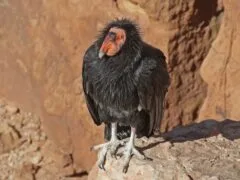The California condor (Gymnogyps californianus) is the largest land bird in North America, with a wingspan reaching up to 3 meters (9.8 feet). Historically widespread across the western part of the continent, its population declined drastically due to habitat destruction, lead poisoning, and hunting. By 1987, the species was extinct in the wild, with all […]
Category: Cathartidae
Why the Vulture is plain colored
In the beginning, birds were created without covering. Ashamed of their long legs and ill-shaped bodies, they hid themselves among trees and rocks. They were also without song, as their throats had not yet been fitted for producing music. Long afterward, they learned their songs from whispering leaves, falling rain, running brooks and whistling winds. […]
The Hunter and the Buzzard who switched forms
A hunter had been all day looking for deer in the mountains without success until he was completely tired out and sat down on a log to rest and wonder what he should do, when a buzzard, a bird which always has magic powers, came flying overhead and spoke to him. asking him what was […]
How the Turkey Vulture lost his head feathers
WHY THE BUZZARD’S HEAD IS BARE The buzzard used to have a line topknot, of which he was so proud that he refused to eat carrion, and while the other birds were pecking at the body of a deer or other animal which they had found he would strut around and say: “You may have […]
Bird stories, Californian Condor (Gymnogyps californianus)
Dances were performed by the Cumash tribe for both religious and secular purposes, and some of them were inspired by animals. The Condor dancer struck two sticks together, enabling him to fly long distances quickly. Wearing their feathered regalia, the dancers were transformed from their human state into spiritual beings. Connections between people and the […]
Black Vulture (Coragyps atratus)
The Sertanejos of Brazil make medicine of the liver of this bird, it is extracted and cooked and then reduced to a powder. If this powder is added to the drink or food of an alcoholic, without that person being aware of it, they will supposedly be cured of alcoholism. Ingesting fat from the bones […]
Observations on Migratory Turkey Vultures and Lesser Yellow-headed Vultures in Northern Colombia
Turkey Vulture (Cathartes aura) Science Article 1 abstract Turkey Vultures (Cathartes aura) breed from southern Canada to Tierra del Fuego, while Lesser Yellowheaded Vultures (Cathartes burrovianus) occur from M xico through Central America to northern Argentina and Uruguay (Meyer de Schauensee 1966).It has long been known that Turkey Vultures breeding in the northern parts of […]
Olfactory sensitivity of the Tturkey vulture (Cathartes aura) to three carrion-associated odorants
Turkey Vulture (Cathartes aura) Science Article 2 abstract The Turkey Vulture (Cathartes aura) is generally thought to rely on olfactory cues to locate carrion. Because vertically rising odorants are dispersed rapidly by wind turbulence, we predict that Turkey Vultures should be highly sensitive to these chemicals to detect them at foraging altitudes. STEVEN A. SMITH […]
Observations on Migratory Turkey Vultures and Lesser Yellow-headed Vultures in Northern Colombia
Turkey Vulture (Cathartes aura) Science Article 1 abstract Turkey Vultures (Cathartes aura) breed from southern Canada to Tierra del Fuego, while Lesser Yellowheaded Vultures (Cathartes burrovianus) occur from M xico through Central America to northern Argentina and Uruguay (Meyer de Schauensee 1966).It has long been known that Turkey Vultures breeding in the northern parts of […]
OLFACTORY SENSITIVITY OF THE TURKEY VULTURE (CATHARTES AURA) TO THREE CARRION-ASSOCIATED ODORANTS
Turkey Vulture (Cathartes aura) Science Article 2 abstract The Turkey Vulture (Cathartes aura) is generally thought to rely on olfactory cues to locate carrion. Because vertically rising odorants are dispersed rapidly by wind turbulence, we predict that Turkey Vultures should be highly sensitive to these chemicals to detect them at foraging altitudes. Olfactory thresholds to […]

